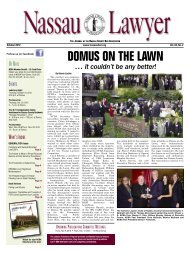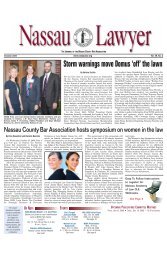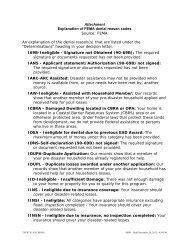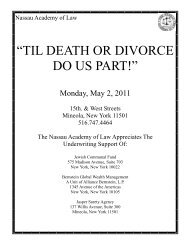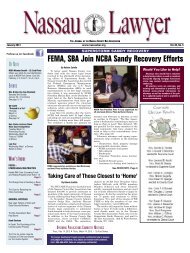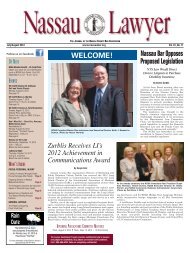394 B.R. 721 Page 10394 B.R. 721, 50 Bankr.Ct.Dec. 192(Cite as: 394 B.R. 721)feat a motion to dismiss (internal quotation marks omitted)).Instead, the plaintiff must "amplify a claim withsome factual allegations in those contexts where suchamplification is needed to render the claim plausible."Iqbal, 490 F.3d at 157-58 (emphasis in original). "[O]ncea claim has been stated adequately, it may be supportedby showing any set <strong>of</strong> facts consistent with the allegationsin the complaint." Bell Atl. Corp., 127 S.Ct. at 1969; accordRoth v. Jennings, 489 F.3d 499, 510 (2d Cir.2007)."[C]ourts must consider the complaint in its entirety, aswell as other sources courts ordinarily examine when rulingon *731Rule 12(b)(6) motions to dismiss, in particular,documents incorporated into the complaint by reference,and matters <strong>of</strong> which a court may take judicial notice."Tellabs, 127 S.Ct. at 2509. Courts may also consider"any written instrument attached to the complaint,statements or documents incorporated into the complaintby reference, legally required public disclosure documentsfiled with the SEC, and documents possessed by orknown to the plaintiff and upon which it relied in bringingthe suit." ATSI Commcns, 493 F.3d at 98; accord Roth,489 F.3d at 509; Chambers v. Time Warner, Inc., 282F.3d 147, 152-53 (2d Cir.2002); Rothman v. Gregor, 220F.3d 81, 88-89 (2d Cir.2000). "Where a plaintiff's conclusoryallegations are clearly contradicted by documentaryevidence incorporated into the pleadings by reference,however, the court is not required to accept them." Labajov. Best Buy Stores, L.P., 478 F.Supp.2d 523, 528(S.D.N.Y.2007); accord Kuhne v. Midland Credit Mgmt.,Inc., No. 06 Civ. 5888(DC), 2007 WL 2274873, at *1(S.D.N.Y. Aug. 9, 2007); Matusovsky v. Merrill Lynch,186 F.Supp.2d 397, 400 (S.D.N.Y.2002).A. Counts I through IV[1] As noted, Counts I through IV hinge on the applicability<strong>of</strong> the doctrine <strong>of</strong> collapsing. Under appropriatecircumstances, multiple transactions will be collapsed andtreated as steps in a single transaction for analysis underthe fraudulent conveyance laws. HBE Leasing Corp. v.Frank, 48 F.3d 623, 635 (2d Cir.1995); Orr v. KinderhillCorp., 991 F.2d 31, 35 (2d Cir.1993)("[A]n allegedlyfraudulent conveyance must be evaluated in context;[w]here a transfer is only a step in a general plan, the planmust be viewed as a whole with all its composite implications.")(internalquotation marks and citations omitted).Although collapsing is usually applied to leveraged buyouts,the doctrine applies more generally to the following"paradigmatic scheme":one transferee gives fair value to the debtor in exchangefor the debtors property, and the debtor then gratuitouslytransfers the proceeds <strong>of</strong> the first exchange to asecond transferee. The first transferee thereby receivesthe debtors property, and the second transferee receivesthe consideration, while the debtor retains nothing.HBE Leasing, 48 F.3d at 635.[2] A party seeking to collapse a series <strong>of</strong> transactionsmust satisfy two elements, or prongs. First, "the considerationreceived from the first transferee must be reconveyedby the debtor for less than fair consideration orwith an actual intent to defraud creditors." Id. If the debtorretains the consideration, or transfers it for valuable consideration,its estate is not unfairly diminished and theinitial transfer is not fraudulent. Id.[3][4] Second, the initial transferee must have actual orconstructive knowledge <strong>of</strong> the entire scheme that rendersthe exchange with the debtor fraudulent. Id.; accord In reBest Prods. Co., Inc., 168 B.R. 35, 56- 57(Bankr.S.D.N.Y.1994)(courts frequently examine the defendant'sknowledge "<strong>of</strong> the structure <strong>of</strong> the entire transactionand ... whether its components were part <strong>of</strong> a singlescheme")(internal quotation marks and citation omitted);Official Comm. <strong>of</strong> Unsecured Creditors <strong>of</strong> Sunbeam Corp.v. Morgan Stanley Co. (In re Sunbeam Corp.), 284 B.R.355, 370 (Bankr.S.D.N.Y.2002)("Courts have collapsed aseries <strong>of</strong> transactions into one transaction when it appearsthat despite the formal structure erected and the labelsattached, the segments, in reality, comprise a single integratedscheme when evaluated focusing on the knowledgeand intent <strong>of</strong> the parties *732 involved in the transaction.").Actual knowledge exists where the "initial transferorwas intimately involved in the formulation or implementation<strong>of</strong> the plan by which the proceeds <strong>of</strong> theloan were channeled to the third-party." Sunbeam, 284B.R. at 370. Constructive knowledge, on the other hand,will be found where the initial transferee became aware <strong>of</strong>circumstances that should have led it to inquire furtherinto the circumstances <strong>of</strong> the transaction, but failed tomake the inquiry. HBE Leasing, 48 F.3d at 636.Counts I through III seek to invalidate the loan and purchaseobligations under the fraudulent transfer provisions<strong>of</strong> New York and federal bankruptcy law. The Pre-Petition Banks and SPM have, however, assigned theirclaims and related security interests, and no longer assertthem against the debtors or their estates. Furthermore, thedebtors settled with the assignees under the confirmedchapter 11 plan, and are not challenging the debts or liensin their hands. Thus, the mere avoidance <strong>of</strong> the obliga-© 2009 Thomson Reuters. No Claim to Orig. US Gov. Works.
394 B.R. 721 Page 11394 B.R. 721, 50 Bankr.Ct.Dec. 192(Cite as: 394 B.R. 721)tions would not provide any meaningful relief.[5] The validity <strong>of</strong> the loan obligations is neverthelesscrucial to Count IV. Asserted solely as a constructivefraudulent transfer claim, Count IV seeks to avoid andrecover the value <strong>of</strong> the liens conveyed to the Pre-PetitionBanks and SPM to secure the repayment <strong>of</strong> the obligations.A valid antecedent debt provides adequate considerationto support the grant <strong>of</strong> a security interest.Ultramar Energy Ltd. v. Chase Manhattan Bank, N.A.,191 A.D.2d 86, 599 N.Y.S.2d 816, 819(N.Y.App.Div.1993)("Even though insolvent, a debtormay properly assign assets to a creditor as security for anantecedent debt although the effect <strong>of</strong> the transfer will beto prefer that creditor."); see Geron v. Palladin OverseasFund, Ltd. (In re AppliedTheory Corp.), 330 B.R. 362,363 (S.D.N.Y.2005)("In its appeal, the appellant urges usto reject the per se rule consistently applied in this District,which provides that a debtors grant <strong>of</strong> a securityinterest in its assets to a lender who has previously giventhe debtor a cash loan may not be considered a fraudulentconveyance."). The plaintiff must, therefore, invalidatethe obligations to avoid and recover the value <strong>of</strong> the cor-responding liens.With this in mind, we turn to the elements <strong>of</strong> the debtors'collapsing claim.1. The First ProngThe parties debate the degree <strong>of</strong> specificity that theseallegations must meet. In particular, they argue over theTo satisfy the first prong <strong>of</strong> the collapsing doctrine, theplaintiff must plead and ultimately prove that (1) the Pre-Petition Banks and SPM transferred consideration to thedebtors; (2) the debtors reconveyed the consideration tothe Fortgang Affiliates; and (3) the reconveyance <strong>of</strong> theloan proceeds and gold was made with actual or constructivefraudulent intent within the meaning <strong>of</strong> the fraudulenttransfer laws. The Amended Complaint alleges that thedebtors received at least $129.4 million in loan proceedsfrom the Pre-Petition Banks and another $32 millionworth <strong>of</strong> gold from SPM, and incurred correspondingobligations. In addition, the Amended Complaint allegesthat the debtors retransferred the $129.4 million, as part <strong>of</strong>their net transfer <strong>of</strong> over $175 million, to the FortgangAffiliates. Finally the Amended Complaint alleges thatMFS reconveyed $22 million worth <strong>of</strong> the SPM gold,which was already in the possession <strong>of</strong> the Fortgang Af-filiates at the time <strong>of</strong> the sale.need to particularize each transfer. The sufficiency <strong>of</strong> thetransfer allegations in the Amended Complaint dependson whether the plaintiff is relying on theories <strong>of</strong> actual* 733 or constructive fraud, and is discussed immediatelybelow.a. Actual Fraud[6] The plaintiff contends that the Affiliate Transferswere made with actual fraudulent intent under both NewYork and bankruptcy law, and hence, may be set asidewithout regard to the adequacy <strong>of</strong> any consideration receivedby the debtors. A claim to avoid an intentionalfraudulent conveyance or transfer must satisfy the pleadingrequirements <strong>of</strong> Rule 9(b) <strong>of</strong> the Federal Rules <strong>of</strong>Civil Procedure. [FN8] Sharp Int'l Corp. v. State StreetBank & Trust Co. (In re Sharp Int'l Corp.), 403 F.3d 43,56 (2d Cir.2005); Atlanta Shipping Corp., Inc. v. Chem.Bank, 818 F.2d 240, 251 (2d Cir.1987); Nisselson v. DrewIndus., Inc. (In re White Metal Rolling & StampingCorp.), 222 B.R. 417, 428 (Bankr.S.D.N.Y.1998). Rule9(b) requires the plaintiff to plead claims <strong>of</strong> actual or intentionalfraud with particularity.FN8. Rule 9(b) states:(b) FRAUD OR MISTAKE; CONDITIONS OFMIND. In alleging fraud or mistake, a party muststate with particularity the circumstances constitutingfraud or mistake. Malice, intent, knowledge,and other conditions <strong>of</strong> a person's mindmay be alleged generally.[7][8] The party asserting an intentional fraudulent transferclaim must "specify the property that was allegedlyconveyed, the timing and frequency <strong>of</strong> those allegedlyfraudulent conveyances, [and] the consideration paid."United Feature Syndicate, Inc. v. Miller Features Syndicate,Inc., 216 F.Supp.2d 198, 221 (S.D.N.Y.2002); accordAlnwick v. European Micro Holdings, Inc., 281F.Supp.2d 629, 646 (E.D.N.Y.2003) (dismissing intentionalfraudulent transfer claim that failed to identify theassets that were transferred and identified the date <strong>of</strong> thetransfer as "on or about 2001"); Wujin Nanxiashu SecantFactory v. Ti-Well Int'l Corp., No. 01 Civ. 8871(JCF),2002 WL 1144903, at *4 (S.D.N.Y. May 29,2002)(dismissing intentional fraudulent transfer claim thatfailed to identify the property that was transferred, whenthe transfers occurred and to whom the transfers weremade); see also Fed.R.Civ.P. App. <strong>of</strong> Forms, Form 21 at 4. Consequently, allegations that a debtor made an aggregateamount or series <strong>of</strong> cash or other transfers over aperiod <strong>of</strong> time, without further particularization, are insuf-© 2009 Thomson Reuters. No Claim to Orig. US Gov. Works.
- Page 1 and 2:
Nassau Academy of LawCLE Live Class
- Page 3 and 4:
McKinney's Debtor and Creditor Law
- Page 5 and 6:
McKinney's Debtor and Creditor Law
- Page 7 and 8:
McKinney's Debtor and Creditor Law
- Page 9 and 10:
McKinney's Debtor and Creditor Law
- Page 11 and 12:
McKinney's Debtor and Creditor Law
- Page 13 and 14:
McKinney's Debtor and Creditor Law
- Page 15 and 16:
McKinney's Debtor and Creditor Law
- Page 17 and 18:
McKinney's Debtor and Creditor Law
- Page 19 and 20:
BAKER & HOSTETLER LLP45 Rockefeller
- Page 21 and 22:
usiness of defendant Bernard L. Mad
- Page 23 and 24:
BACKGROUND, THE TRUSTEE, AND STANDI
- Page 25 and 26:
Madoff who received fraudulent tran
- Page 27 and 28:
ased on fictitious profits and for
- Page 29 and 30: 28. BLMIS funds were also used to p
- Page 31 and 32: Madoff, and her niece, Shana Madoff
- Page 33 and 34: 42. Ruth Madoff was never an employ
- Page 35 and 36: FIRST CAUSE OF ACTIONTURNOVER AND A
- Page 37 and 38: 66. At the time of each of the Two-
- Page 39 and 40: Transfers; (b) directing that the S
- Page 41 and 42: EIGHTH CAUSE OF ACTIONUNDISCOVERED
- Page 43 and 44: TENTH CAUSE OF ACTIONDISALLOWANCE O
- Page 45 and 46: 111. Mrs. Madoff benefited from the
- Page 47 and 48: WHEREFORE, the Trustee respectfully
- Page 49 and 50: 2(c)(3): (a) preserving the Subsequ
- Page 51 and 52: 302 B.R. 760 Page 1302 B.R. 760(Cit
- Page 53 and 54: 302 B.R. 760 Page 3302 B.R. 760(Cit
- Page 55 and 56: 302 B.R. 760 Page 5302 B.R. 760(Cit
- Page 57 and 58: 302 B.R. 760 Page 7302 B.R. 760(Cit
- Page 59 and 60: 302 B.R. 760 Page 9302 B.R. 760(Cit
- Page 61 and 62: 302 B.R. 760 Page 11302 B.R. 760(Ci
- Page 63 and 64: 302 B.R. 760 Page 13302 B.R. 760(Ci
- Page 65 and 66: 302 B.R. 760 Page 15302 B.R. 760(Ci
- Page 67 and 68: 302 B.R. 760 Page 17302 B.R. 760(Ci
- Page 69 and 70: 302 B.R. 760 Page 19302 B.R. 760(Ci
- Page 71 and 72: 394 B.R. 721 Page 1394 B.R. 721, 50
- Page 73 and 74: 394 B.R. 721 Page 3394 B.R. 721, 50
- Page 75 and 76: 394 B.R. 721 Page 5394 B.R. 721, 50
- Page 77 and 78: 394 B.R. 721 Page 7394 B.R. 721, 50
- Page 79: 394 B.R. 721 Page 9394 B.R. 721, 50
- Page 83 and 84: 394 B.R. 721 Page 13394 B.R. 721, 5
- Page 85 and 86: 394 B.R. 721 Page 15394 B.R. 721, 5
- Page 87 and 88: 394 B.R. 721 Page 17394 B.R. 721, 5
- Page 89 and 90: 394 B.R. 721 Page 19394 B.R. 721, 5
- Page 91 and 92: 394 B.R. 721 Page 21394 B.R. 721, 5
- Page 93 and 94: 397 B.R. 642 Page 2397 B.R. 642(Cit
- Page 95 and 96: 397 B.R. 642 Page 4397 B.R. 642(Cit
- Page 97 and 98: 397 B.R. 642 Page 6397 B.R. 642(Cit
- Page 99 and 100: 397 B.R. 642 Page 8397 B.R. 642(Cit
- Page 101 and 102: 397 B.R. 642 Page 10397 B.R. 642(Ci
- Page 103 and 104: 397 B.R. 642 Page 12397 B.R. 642(Ci
- Page 105 and 106: 397 B.R. 642 Page 14397 B.R. 642(Ci
- Page 107 and 108: 443 F.3d 180 Page 2443 F.3d 180(Cit
- Page 109 and 110: 443 F.3d 180 Page 4443 F.3d 180(Cit
- Page 111 and 112: 443 F.3d 180 Page 6443 F.3d 180(Cit
- Page 113 and 114: 443 F.3d 180 Page 8443 F.3d 180(Cit
- Page 115 and 116: 443 F.3d 180 Page 10443 F.3d 180(Ci
- Page 117 and 118: 443 F.3d 180 Page 12443 F.3d 180(Ci
- Page 119 and 120: Page 2257 A.D.2d 526, 684 N.Y.S.2d
- Page 121 and 122: Page 4257 A.D.2d 526, 684 N.Y.S.2d
- Page 123 and 124: Page 6257 A.D.2d 526, 684 N.Y.S.2d
- Page 125 and 126: 770 N.Y.S.2d 421 Page 22 A.D.3d 780
- Page 127 and 128: Page 14 A.D.3d 495, 773 N.Y.S.2d 71
- Page 129: Page 34 A.D.3d 495, 773 N.Y.S.2d 71
- Page 132 and 133:
780 N.Y.S.2d 409 Page 29 A.D.3d 553
- Page 134 and 135:
Page 134 A.D.3d 231, 824 N.Y.S.2d 3
- Page 136 and 137:
Page 334 A.D.3d 231, 824 N.Y.S.2d 3
- Page 138 and 139:
Page 2991 F.2d 31(Cite as: 991 F.2d
- Page 140 and 141:
Page 4991 F.2d 31(Cite as: 991 F.2d
- Page 142 and 143:
Page 6991 F.2d 31(Cite as: 991 F.2d
- Page 144 and 145:
FRAUDULENT TRANFERENCESRonald M. Te
- Page 146 and 147:
Nursing home case_ Transfer of pers
- Page 148 and 149:
Sections 548 and 544 work in concer
- Page 150 and 151:
U.S. Supreme CourtBFP v. Resolution
- Page 152 and 153:
example, from net 15 to COD; or cha
- Page 154 and 155:
Bankruptcy Code Section§ 548. Frau
- Page 156:
Ron Terenzi is a founding partner a



